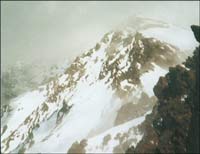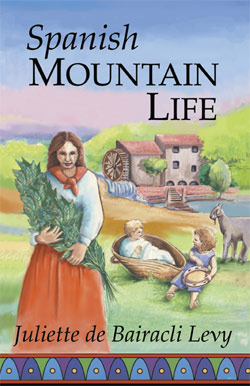Spanish Mountain
Life (continued)
by
Juliette de Bairacli-Levy
continued
from the October Wise Woman ezine...
We also took walks on the mountain every morning, despite
the cold of that unnatural Andalusian spring. The breath of
the sierra wind was icy; snow and hail came in it often enough.
It was colder than anything that I had known elsewhere in
Europe, including the French Alps in February, or even during
mid-winter on the sea-coast beyond Istanbul in Turkey.
 The Sierra Nevada peasants said: 'This wind enters the heart
of the bones', and they would wrap their woollen cloaks tighter
around their lean bodies. But Raflk and I had no woollen clothes,
for I had expected to find the hot Andalusian sun which I
had known in the spring in Granada two years ago. We shivered
in our thin clothes and were thankful when the evening brazier
of olive-wood charcoal was lit in our room in the inn and
we could warm away the cold of the day.
The Sierra Nevada peasants said: 'This wind enters the heart
of the bones', and they would wrap their woollen cloaks tighter
around their lean bodies. But Raflk and I had no woollen clothes,
for I had expected to find the hot Andalusian sun which I
had known in the spring in Granada two years ago. We shivered
in our thin clothes and were thankful when the evening brazier
of olive-wood charcoal was lit in our room in the inn and
we could warm away the cold of the day.
I could not forgo our walks despite the snow
and rain. For all the terraced slopes of the fertile lower
areas of the sierra were in blossom. Fruit trees of every
kind seemed as multitudinous as the sierra animals, and the
blossom lay lovely upon them, of all colours of white and
pink, from the ivory of pear flowers to the darker rose hue
of quince and almond. Green-white was the most fragrant blossom
of orange and lemon trees. Trees in blossom, seen against
a turquoise sky when the rains cleared, are a fair thing,
and later the carmine of pomegranate flowers against the blue
was the loveliest of all.
I knew some sadness when all the snow melted
on the sierra heights around Lanjaron, for the eternal snow
of the Sierra Nevada was on higher ranges, out of walking
or mule-riding distance of the molino Gongoras. But with the
melting of the snow came the wild purple irises, tall as Rafik,
beautiful banners of them along the borders of the streams
and waving upon the wet parts of the foothills. Their scent
was a delight and I gathered armfuls of them for my room in
the water-mill. They flowered at Eastertime, the Semana Santa
of Spain, and the peasants told me that they represented the
pain of Christ; certainly the purple iris was much used in
the church processions of that holy week.
Later, the peasants also said that the white
Madonna lily- the azucena, so celebrated in songs and dances
of Spain represented the happiness of Christ, his triumph
over death, and that the white lilies would blossom when the
irises had died away. And that was so. So soon as the irises
had withered on the mountain, the madonna lilies flowered
thick along the border of the upper mill stream of the molino
Gongoras, and like the white of swans were reflected in the
sunlit waters of the stream. They too then had their turn
in the church processions, especially the June celebration
of Corpus Christi.
Spanish Mountain
Life (continued)
by
Juliette de Bairacli-Levy
to
to be continued....
click
here for another excerpt from Juliette's Nature's Children,
"treatment of fevers"
“In Memory of Juliette the Grandmother of Herbal medicine”


Spanish Mountain Life
Author: Juliette de Bairacli Levy.
This jewel-like memoir by noted herbalist and traveler Juliette de Bairacli Levy details her personal struggle against typhus fever, during which she gave birth to her second child, Luz, who had to be suckled by a nanny goat. As ever we are embraced by Juliette's love of nature and animals, and welcomed onlookers as she relates with people whose lives are far different from ours. 114 pages,
index, illustrations.
buy
Spanish Mountain Life in our Bookshop


 The Sierra Nevada peasants said: 'This wind enters the heart
of the bones', and they would wrap their woollen cloaks tighter
around their lean bodies. But Raflk and I had no woollen clothes,
for I had expected to find the hot Andalusian sun which I
had known in the spring in Granada two years ago. We shivered
in our thin clothes and were thankful when the evening brazier
of olive-wood charcoal was lit in our room in the inn and
we could warm away the cold of the day.
The Sierra Nevada peasants said: 'This wind enters the heart
of the bones', and they would wrap their woollen cloaks tighter
around their lean bodies. But Raflk and I had no woollen clothes,
for I had expected to find the hot Andalusian sun which I
had known in the spring in Granada two years ago. We shivered
in our thin clothes and were thankful when the evening brazier
of olive-wood charcoal was lit in our room in the inn and
we could warm away the cold of the day.

